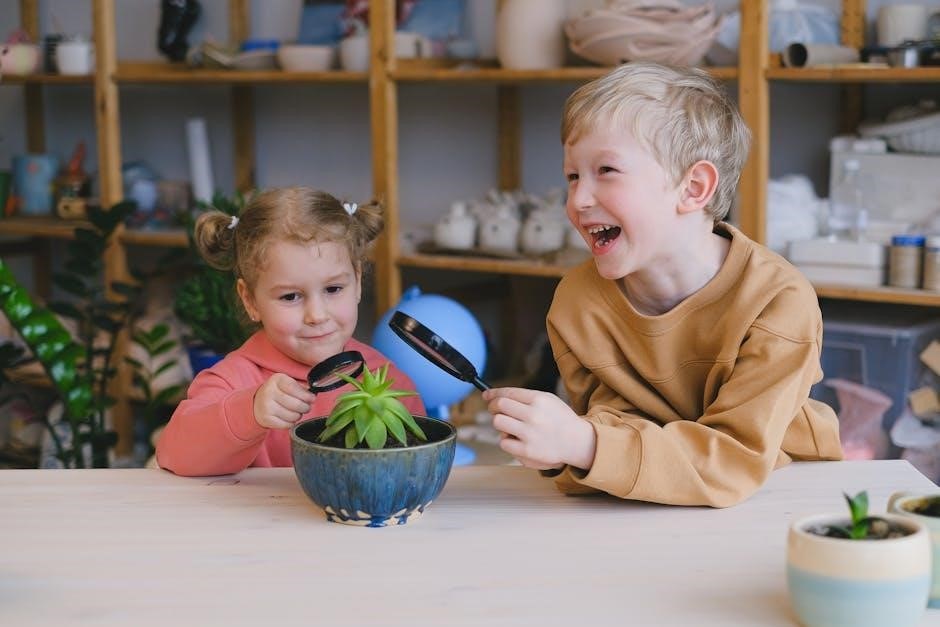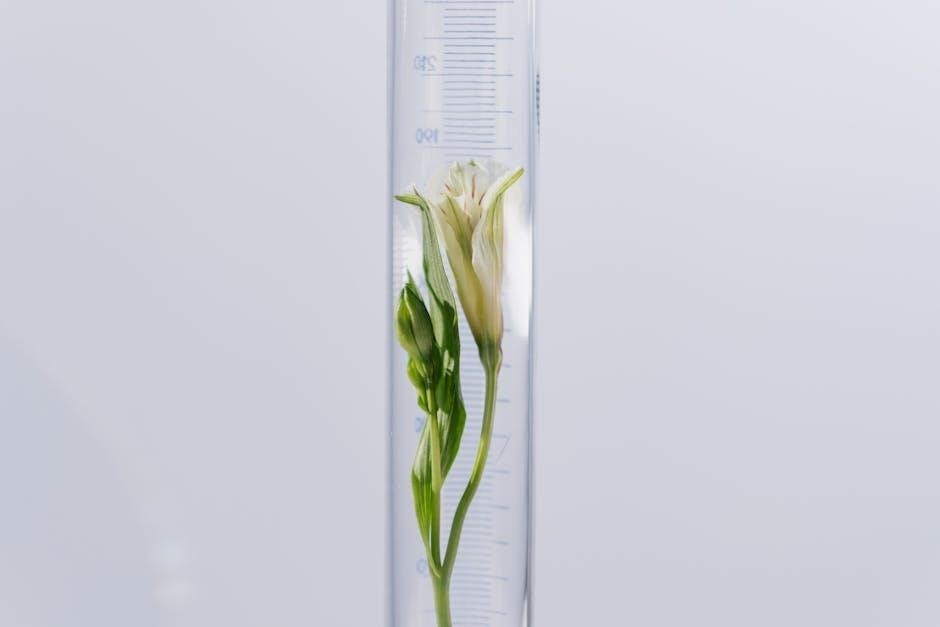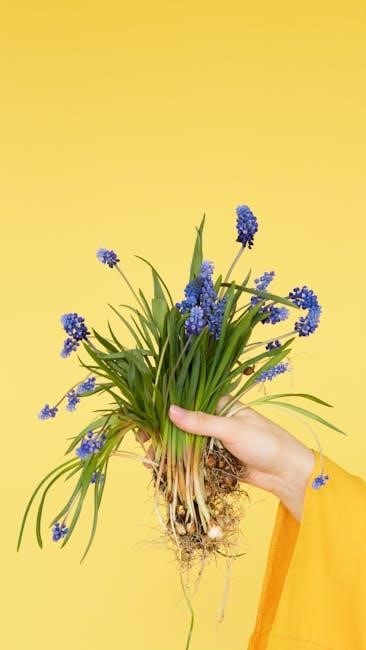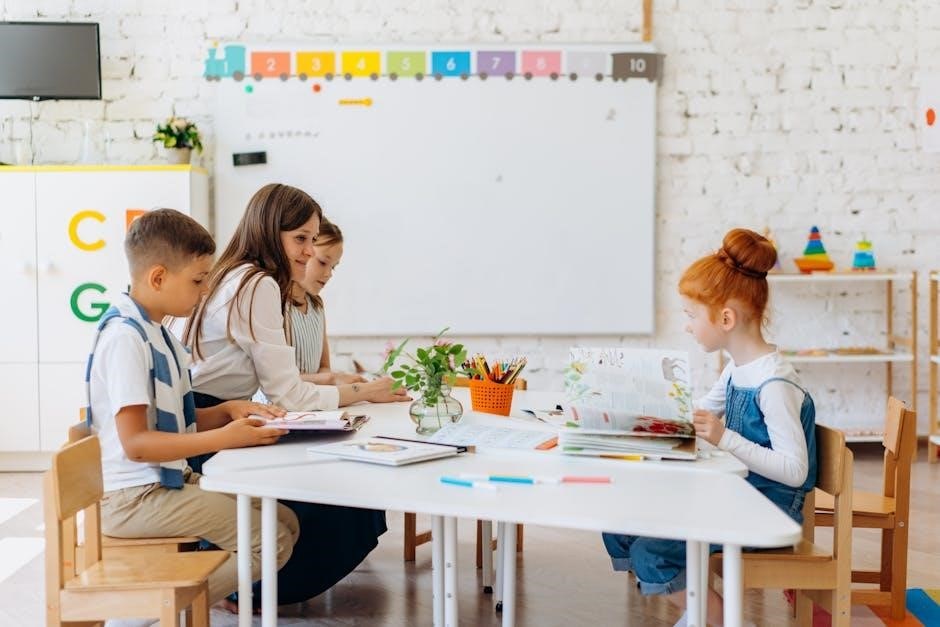The Creative Curriculum’s Gardening Study offers a hands-on, exploratory approach, fostering curiosity and learning through nature, STEM integration, and creative expression, while engaging families in education.
Overview of the Gardening Study Curriculum
The Gardening Study Curriculum, part of the Creative Curriculum, is a six-week program designed for preschoolers, focusing on hands-on learning and exploration. It includes daily lesson plans, study signs, book ideas, and questions of the day to guide teachers. The curriculum integrates science, math, and literacy, encouraging children to explore plant growth, soil, and ecosystems. It also involves families through letters and activities, fostering a sense of community and shared learning experiences. This structured yet flexible approach promotes curiosity and foundational skills in young learners.
Importance of Gardening in Early Childhood Education
Gardening in early childhood education fosters essential life skills, including responsibility, curiosity, and environmental awareness. It provides hands-on opportunities for children to explore nature, promoting STEM learning and creativity. Gardening also enhances social-emotional development by encouraging collaboration and pride in nurturing plants. It connects academic concepts like science, math, and literacy to real-world experiences, making learning engaging and meaningful. By involving families, it builds a sense of community and extends learning beyond the classroom, creating a holistic educational experience that benefits children’s overall growth and development.

Key Concepts and Benefits of the Gardening Study
The Gardening Study promotes hands-on learning, fostering curiosity, creativity, and critical thinking while developing foundational skills in science, math, and literacy through engaging, nature-based activities.
Understanding Plant Growth and Development
Children explore the life cycle of plants, from seed germination to harvest, learning about photosynthesis, soil composition, and the role of sunlight and water. Hands-on activities, such as planting seeds and observing growth, help them grasp biological processes. This foundational knowledge fosters a deeper appreciation for nature and promotes scientific inquiry. Through guided discussions and experiments, students develop critical thinking skills while understanding the essential needs of plants and their importance in ecosystems.
Educational Benefits for Children
The Gardening Study fosters hands-on learning, enhancing children’s understanding of STEM concepts, literacy, and problem-solving skills. It encourages curiosity, critical thinking, and creativity while promoting social interaction and teamwork. By engaging in planting, observing, and caring for plants, children develop patience and responsibility. The curriculum also integrates math through measuring and counting, while storytelling and journaling activities refine communication skills. This holistic approach nurtures a connection to nature, preparing children for future academic success and a lifelong appreciation for environmental stewardship.
Connecting Gardening to STEM and Literacy
Gardening seamlessly integrates STEM and literacy, offering a multidimensional learning experience. Children explore science through plant growth and ecosystems, while math is introduced via measuring and counting. Technology is incorporated through tools like plant-growing apps or environmental sensors. Literacy flourishes as students engage in gardening-themed books, journals, and storytelling. This connection fosters critical thinking, creativity, and a deeper understanding of the natural world, making learning engaging and meaningful across multiple subject areas.

Structure and Implementation of the Curriculum
The curriculum is organized into daily and weekly lesson plans, offering flexible activities and projects that integrate gardening across various learning areas, ensuring a cohesive and engaging experience.
Daily and Weekly Lesson Plans
The curriculum includes a six-week structured plan with daily activities, focusing on hands-on learning. Each day, children engage in tasks like planting seeds, observing growth, and documenting findings. Weekly plans emphasize STEM integration, literacy, and art, ensuring a well-rounded approach. Teachers can adapt lessons to meet individual needs, promoting exploration and critical thinking. The guide provides materials for indoor and outdoor activities, encouraging continuous learning. Family involvement is encouraged through take-home projects, fostering a collaborative educational environment. This framework ensures a balanced and engaging gardening study experience for young learners.
Integrating Gardening into Cross-Curricular Activities
Gardening seamlessly connects with STEM, literacy, and art, enriching the curriculum. Students explore plant life cycles in science, while math involves measuring growth. Literacy is enhanced through gardening-themed books and journaling. Art projects, like flower-inspired crafts, encourage creativity. Social-emotional learning is fostered through teamwork in garden maintenance. This holistic approach ensures a comprehensive education, blending academic subjects with hands-on experiences. The curriculum provides tips for integrating gardening into daily routines, making learning engaging and interdisciplinary for young students.

The Role of the Teacher in the Gardening Study
Teachers facilitate hands-on learning, guide explorations, and nurture curiosity, helping children connect with nature and develop essential skills through engaging gardening activities.
Facilitating Hands-On Learning Experiences
Facilitating Hands-On Learning Experiences
Teachers play a crucial role in creating interactive and engaging gardening activities that allow children to explore and learn through direct experience. By providing tools, materials, and guidance, educators help students observe plant growth, understand ecosystems, and develop scientific inquiry skills. These hands-on opportunities foster creativity, critical thinking, and a deeper connection to nature, while also encouraging collaboration and problem-solving among students. The curriculum emphasizes the importance of active participation, making learning meaningful and enjoyable for young learners.
Encouraging Exploration and Discovery
The Creative Curriculum’s Gardening Study encourages children to explore and discover the wonders of nature through hands-on activities and open-ended questions. By fostering curiosity, teachers help students develop a deeper understanding of the natural world. This approach promotes critical thinking, creativity, and a love for learning, as children investigate plant growth, soil composition, and the role of insects in ecosystems. The curriculum’s emphasis on exploration allows children to connect with nature, fostering a sense of wonder and responsibility for the environment. This method supports holistic development, integrating STEM and literacy skills seamlessly into the learning process.
Engaging Families and the Community
Engaging Families and the Community in the Gardening Study encourages participation through family activities, community collaborations, and educational partnerships, fostering a sense of shared responsibility.
Inviting Family Participation in Gardening Activities
Inviting families to participate in gardening activities strengthens the connection between home and school. A letter of explanation is sent to families, encouraging them to contribute items like sand samples or containers. This involvement fosters a sense of community and ownership, allowing children to see their families as partners in learning. Families can assist with planting, maintaining gardens, or sharing gardening tips, creating meaningful experiences. This collaboration enhances the curriculum’s effectiveness and helps children develop a deeper appreciation for nature and responsibility. It also supports cross-generational learning and reinforces the value of teamwork in education.
Building Partnerships with Local Gardens and Experts
Collaborating with local gardens and experts enriches the gardening study curriculum by providing real-world insights and resources. Partnerships allow for field trips, workshops, and interactive sessions led by botanists, landscapers, and horticulturalists. Local nurseries may donate seeds, plants, or tools, enhancing hands-on activities; These connections also offer opportunities for children to participate in community garden projects, fostering civic responsibility and environmental stewardship. By involving experts, the curriculum gains authenticity, while children benefit from diverse perspectives and practical knowledge, making their learning experience more engaging and comprehensive.
Creative Activities and Projects
The gardening study curriculum includes arts, crafts, storytelling, and journaling, fostering creativity and reflection. These activities enhance learning and encourage children to express their gardening experiences innovatively.
Arts and Crafts Inspired by Gardening
Gardening-inspired arts and crafts foster creativity and connection to nature. Activities include flower crown-making, seed collages, and painting garden scenes. Children explore natural materials like soil and leaves, creating textured artworks. These projects encourage imaginative expression while teaching about colors, textures, and growth processes. Crafting garden markers and mini-greenhouses adds functional creativity. Such activities integrate STEM and literacy, inspiring children to view gardening as an artistic and scientific endeavor. They also promote environmental awareness and appreciation for nature’s beauty. These creative outlets make learning engaging and fun, fostering a deeper connection to the gardening study curriculum.

Storytelling and Journaling About Gardening Experiences
Storytelling and journaling are powerful tools for children to reflect on their gardening experiences. Through narratives, they share observations, challenges, and successes, fostering creativity and communication skills. Journaling encourages children to document plant growth, weather changes, and seasonal variations, promoting scientific literacy. Illustrations and writings become a personalized record of their gardening journey, showcasing learning and progress. Teachers can use prompts like “What did you discover today?” to spark reflections. This practice not only enhances writing skills but also deepens children’s connection to nature and their role as caretakers of the garden.

Success Stories and Case Studies
The Creative Curriculum’s gardening study has shown positive outcomes in schools, fostering engagement and learning through hands-on activities and cross-curricular integration, as highlighted in case studies.
Effective Implementation in Various Educational Settings
The Creative Curriculum’s gardening study has been successfully implemented across diverse educational settings, including urban, suburban, and rural schools. In urban areas, container gardens and indoor plants have allowed students to engage in gardening despite limited space. Suburban schools often integrate gardening into outdoor classrooms, while rural schools leverage farm-to-school programs. Community partnerships and teacher creativity have been key to adapting the curriculum, ensuring hands-on learning experiences. This flexibility has made the gardening study accessible and impactful, fostering student engagement and learning across varied environments.
Impact on Student Learning and Development
The Creative Curriculum’s gardening study profoundly enhances student learning by fostering a deep understanding of science, nature, and the environment. It integrates seamlessly with math, literacy, and STEM, promoting critical thinking and problem-solving. Students develop essential life skills through hands-on activities like planting and harvesting, which also encourage teamwork and creativity. The curriculum’s emphasis on observation and documentation boosts scientific inquiry and language development. By engaging in real-world experiences, children cultivate a sense of responsibility and connection to the natural world, fostering emotional and cognitive growth. This holistic approach prepares students for a lifelong appreciation of learning and sustainability.
Addressing Challenges and Solutions
Challenges like limited space or resources are addressed by using container gardens or recycled materials. Solutions include adaptable lesson plans and creative indoor gardening techniques.
Overcoming Limited Space or Resources
Even in spaces with limited room, creative solutions like container gardens or vertical gardening can be implemented. Teachers can utilize recycled materials, such as plastic bottles or cardboard boxes, to create mini-gardens. Hydroponics or indoor gardening techniques also offer alternatives for areas with no outdoor space. Additionally, incorporating community resources, such as local nurseries or botanical gardens, can enhance learning experiences. Families can be encouraged to participate by bringing in small plants or materials. Digital tools and educational apps can further support gardening studies, ensuring accessibility for all students regardless of physical constraints.
Ensuring Year-Round Gardening Opportunities
To maintain year-round gardening engagement, educators can adapt activities to suit different seasons. Indoor gardening projects, such as growing herbs or sprouts, can be implemented during colder months. Seasonal planting and harvesting activities, like fall cleanups or spring seedlings, keep the curriculum dynamic. Additionally, incorporating educational resources like gardening apps or virtual field trips provides continuous learning opportunities. Teachers can also integrate reflective practices, such as journaling or planning future garden projects, to sustain interest and creativity throughout the year, ensuring consistent educational and developmental benefits for students.

The Creative Curriculum’s Gardening Study nurtures children’s holistic development through hands-on learning, fostering creativity, STEM skills, and environmental stewardship, leaving a lasting impact on their educational journey.

Summarizing the Value of the Gardening Study
The Gardening Study within the Creative Curriculum offers a transformative learning experience, blending hands-on exploration with nature-based education. It fosters foundational skills in science, math, and literacy while nurturing creativity and critical thinking. Children develop a deeper connection to the environment, fostering environmental stewardship and a sense of responsibility. The study also promotes social-emotional growth, encouraging collaboration and curiosity. By integrating gardening into daily learning, it creates a holistic approach to education, preparing children for lifelong learning and a meaningful relationship with the natural world.
Encouraging Continuous Learning and Exploration
The Gardening Study promotes a lifelong love for learning by engaging children in hands-on, nature-based experiences. It encourages curiosity, creativity, and critical thinking, fostering a growth mindset. By exploring the natural world, children develop essential skills in observation, experimentation, and problem-solving. The curriculum also inspires families and communities to participate, creating a supportive environment for ongoing discovery. This approach not only enriches academic knowledge but also cultivates a deeper appreciation for the environment, preparing children to become active learners and responsible stewards of the world around them.

Additional Resources and References
Explore the Creative Curriculum Gardening Study PDF for detailed lesson plans, recommended books, and online materials. Visit Teachers Pay Teachers for additional teaching resources and guides.
Recommended Books and Online Materials
Enhance your gardening study with recommended books like Exploring Nature with Children and The Creative Curriculum for Preschool. These resources offer practical activities and lesson plans. Online materials, such as gardening study guides and interactive tools, provide engaging content for teachers. Visit Teachers Pay Teachers for downloadable lesson plans, visual aids, and creative ideas. Additional resources include botanical guides, educational websites, and STEM-related apps to deepen learning experiences. These materials support hands-on exploration, curriculum integration, and student engagement in gardening education.
Accessing the Full PDF Guide
Download the complete Creative Curriculum Gardening Study PDF for in-depth lesson plans, activities, and resources. This guide provides six weeks of daily plans, study signs, and content ideas. Visit trusted educational platforms like Teachers Pay Teachers or the official Creative Curriculum website to access the full PDF. It includes practical tools for teachers, such as material lists and book recommendations, to support engaging gardening experiences. The guide is designed to help educators implement the curriculum effectively, fostering hands-on learning and family involvement in gardening education.

Future Directions in Gardening Education
Expanding the curriculum to older students and integrating technology, such as digital gardening tools, will enhance learning experiences and prepare students for innovative approaches in horticulture and sustainability.
Expanding the Curriculum to Older Students
Expanding the gardening study curriculum to older students involves introducing advanced topics like sustainable practices, botanical science, and eco-friendly technologies. This fosters deeper critical thinking and prepares students for real-world applications in agriculture and environmental science. By integrating cross-curricular connections, such as STEM projects and literacy exercises, older students can explore complex issues like climate change and food security. Hands-on activities, like managing larger gardens or conducting experiments, encourage leadership and collaboration while reinforcing lifelong learning and environmental stewardship. This approach ensures the curriculum remains engaging and relevant for older learners.
Incorporating Technology in Gardening Studies
Incorporating technology into gardening studies enhances engagement and learning through digital tools like soil sensors, plant growth apps, and virtual field trips. Students can use apps to track plant life cycles, monitor environmental conditions, and simulate gardening scenarios. Digital journals and photo documentation allow for reflective learning and progress tracking. Additionally, online resources and educational videos provide access to expert knowledge, fostering a deeper understanding of gardening principles. This blend of technology and nature prepares students for modern agricultural practices, promoting STEM literacy and 21st-century problem-solving skills while maintaining a connection to the natural world.



